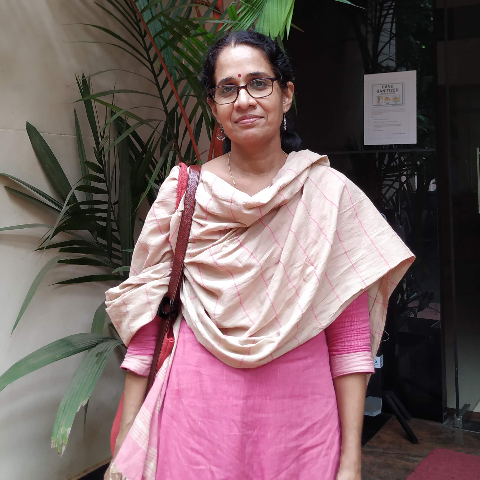Dr. Lakshmi C.

Dr. Lakshmi C.
Professor
Office Address:
Room No.306 Department of Chemistry National Institute of Technology Calicut Kozhikode, Kerala India-673601
B. Sc (1991): Little Flower College, Guruvayoor, Kerala
M. Sc (1993): Calicut University, Kerala
Ph. D (2001): IICT, Hyderabad, Osmania University; Supervisor: Dr. Darshan Ranganathan
Post Doctoral Research Associate (2001-2004): Department of Chemistry and Biochemistry, University of Notre Dame, Indiana, USA; Supervisor: Prof. Bradley D Smith
Educational Qualifications
-
B. Sc (1991): Little Flower College, Guruvayoor, Kerala
-
M. Sc (1993): Calicut University, Kerala
-
Ph. D (2001): IICT, Hyderabad, Osmania University; Supervisor: Dr. Darshan Ranganathan
-
Post Doctoral Research Associate (2001-2004): Department of Chemistry and Biochemistry, University of Notre Dame, Indiana, USA; Supervisor: Prof. Bradley D Smith
Journals
-
Kanneth S. Shurooque, Diana Mathew, Pattiyil Parameswaran, Anjali K. Sajeev, K. N. Narayanan Unni, and Lakshmi Chakkumkumarath* “Substituent-controlled photophysical responses in dihydropyridine derivatives and their application in the detection of volatile organic contaminants” J. Org. Chem. 2023, 88, 15007−15017.
-
Vasu Drisya, Kanneth S. Shurooque, Soumya Das, and Lakshmi Chakkumkumarath*“Fmoc-phenylalanine-based fluorimetric and colorimetric dual-channel probes for the detection of Fe3+, Cu2+ and F-” Journal of Photochemistry & Photobiology, A: Chemistry 442 (2023) 114796.
-
Thekke Kunhalath Jithinraj, Velluvakandi Chaluvalappil Saheer and Lakshmi Chakkumkumarath *, "Chiral 8-aminoBODIPY-based fluorescent probes with site selectivity for the quantitative detection of HSA in biological samples" , Analyst, 2023, 148, 286 (Analyst Hot Articles 2023).
-
Jais Kurian, Kanneth S. Shurooque, Venkatachalam Ramkumar, Lakshmi Chakkumkumarath* and Muraleedharan Kannoth M*, “Delocalization Effects and Tunable Emission in a Class of Charged Cyclazines with Nitrogen on the Periphery”, Org. Lett. 2021, 23, 3354−3358.
-
Thekke Thattariyil Divya, Darpan Raghav, Krishnan Rathinasamy*, Lakshmi Chakkumkumarath*, “Multifunctional fluorescent leucomalachite green derivatives for chemodosimetric detection of Fe3+, specific imaging of lipid droplets and intracellular pH monitoring”, New J. Chem., 2019,43, 16349-16358.
-
R. Kalluruttimmal, D. T. Thattariyil, A. P. Parambil, A. K. Sen, L. Chakkumkumarath*, and K. M. Muraleedharan* “Electronically-tuned Triarylmethine Scaffold for Fast and Continuous Monitoring of H2S Levels in Biological Samples,” Analyst, 2019, 144, 4210–4218.
-
T. T. Divya, K. Ramshad, V. C. Saheer, and L. Chakkumkumarath*, “Self-reversible Mechanochromism and Aggregation Induced Emission in Neutral Triarylmethanes and their Application in Water Sensing,” New J. Chem., 2018, 42, 20227–20238.
-
Abhineeshbabu Thottiparambil, Indu Purushothaman, Susmita De, Pattiyil Parameswaran*, P. Shifana Beegum, P. K. Sudhadevi Antharjanam, and Lakshmi Chakkumkumarath*,“Differential reactivity of 3H-indole styrylcyanines: Intermolecular [4π + 2π] cycloaddition vs. proton - shift coupled six - electron electrocyclization”, Tetrahedron, 2018, 74, 2999-3006.
-
A. Thottiparambil, P. R. Anil Kumar and L. Chakkumkumarath*, Styrylcyanine-based ratiometric and tunable fluorescent pH sensors”, RSC Adv., 2014, 4, 56063-56067.
-
Leevy, M. W; Johnson, J. R; Lakshmi, C; Morris, J; Marquez, M; Smith, B. D."Selective recognition of bacterial membranes by zinc (II)-coordination complexes". Chem Commun, 2006, 15, 1595- 1597.
-
Hanshaw, R. G; Lakshmi, C; Lambert, T. N; Smith, B. D. "Fluorescent detection of apoptotic cells by using a zinc coordination complex with a selective affinity for membrane surfaces enriched with phosphatidylserine". Chembiochem, 2005, 6(12), 2214-2220.
-
Koulov, A. V.; Hanshaw, R. G.; Stucker, K. A.; Lakshmi, C; Smith, B. D. "Biophysical studies of a synthetic mimic of the apoptosis-detecting protein annexin V". Israel Journal of Chemistry, 2005, 45, 373-379.
-
Lakshmi, C.; Hanshaw, R. G; Smith, B. D. "Fluorescent labeled Zn-complexes as sensors for phosphatidylserine enriched surfaces", Tetrahedron, 2004, 60, 11307-11315.
-
Koulov, A. V.; Stucker, K. A.; Lakshmi, C.; Robinson, P. J.; Smith, B. D."Detection of apoptotic cells using a fluorescent sensor for membrane surfaces that contain phosphatidylserine", Cell Death Differ., 2003, 10(12), 1357-1359. Highlighted in Chem. Eng. News, 2003 October 6 issue.
-
Ranganathan, D.; Lakshmi, C. "Cystine-based cyclic oligoureas: a new class of hydrogen-bonding electroneutral anion receptors", Chem Commun, 2001, 14, 1250- 1251.
-
Karle, I. L.; Ranganathan, D.; Lakshmi, C. "Demonstration of cystine unit as a promising turn-scaffold for the design of parallel U-shaped two-helix bundle motif. Crystal structure of Cyst (Aibn)2 (n = 3, 4)", Biopolymers, 2001, 59, 301-304.
-
Ranganathan, D.; Lakshmi, C.; Haridas, V.; Gopikumar, M. "Designer cyclopeptides for self-assembled tubular structures", Pure. Appl. Chem. 2000, 72, 355-362.
-
Ranganathan, D.; Lakshmi, C.; Karle, I. L. "Hydrogen-bonded self-assembled peptide nanotubes from cystine-based macrocyclic bisureas", J. Am. Chem. Soc, 1999, 121, 6103-6107.
Research Interests
Bio-organic Chemistry and Physical Organic Chemistry
-
Design and synthesis of luminescent organic molecules for cell imaging and analyte detection.
-
Supramolecular approach for the design of new luminescent materials.
-
K. M. Muraleedharan, C. Lakshmi, K. Ramshad and T. T. Divya, “A method for the selective and sensitive quantification of hydrogen sulfide (H2S) using malachite green derivatives”, Indian Patent, 201741043637, 2017
Sponsored Research Projects
-
"Design and synthesis of Spiropyran based size tunable ionophores: Modular systems for ion transport, sensing and antimicrobial applications", Principal Investigator, Funding Agency: NIT Calicut under Faculty Research Grant Scheme (Amount: 5 Lakhs, Duration: 2010-2013).
-
"Development of Pro-fluorophore Scaffolds to Probe Peptide Aggregation and Conformational Transitions" Principal Investigator, Funding Agency: Department of Science and Technology, Govt. of India (Amount: 20.7 Lakhs, Duration: 2011-2015).
-
"Design, synthesis and evaluation of solid-emissive far red- near lR fluorophores" Principal Investigator, Funding Agency: Department of Science and Technology, Govt. of India (Amount: 40 Lakhs, Duration: 2017-2020).
-
T. T. Divya, L. Chakkumkumarath, “Pyrene-based solid-emissive and AIE active fluorophore with mega stokes shift for sensing water and micro-environment viscosity changes,” 30th Kerala Science Congress held at Government Brennen College, Thalassery during 28-30th January, 2018.
-
T. T. Divya, L. Chakkumkumarath, “Self-reversible mechanochromism and aggregation induced emission in neutral triarylmethanes and their application in water sensing,” International Conference on Materials for the Millennium, MATCON 2019 held at CUSAT during 14-16th March, 2019.
-
C. Lakshmi, Roger G. Hanshaw and Bradley D. Smith. "Zn (II)-dipicolylamine coordination complexes as markers of apoptosis" - Abstract of papers, 228th ACS National Meeting, Philadelphia, PA, USA, August 22-26, 2004.
-
C. Lakshmi, Roger G. Hanshaw and Bradley D. Smith. "Zn (II)-dipicolylamine coordination complexes as markers of apoptosis" - Abstract of papers, 13th International Symposium on Supramolecular Chemistry, Notre Dame, Indiana, USA, July 25-30, 2004.

